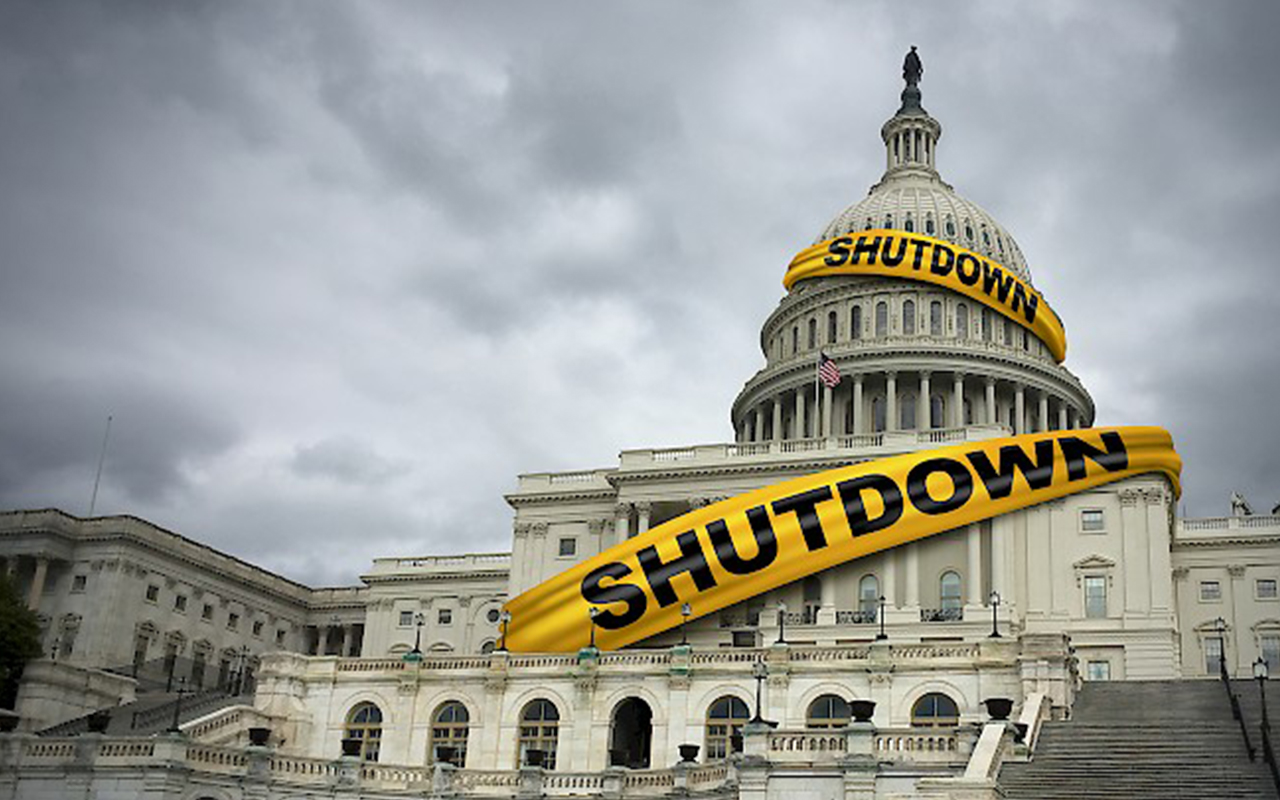The 35-day government shutdown of 2018-2019 became the longest in U.S. government history. Food banks, firefighters, and community services agencies ramped up their food and other care services. Much like during natural disasters, a significant number of federal workers and contractors did not have sufficient savings to cover expenses during this hiatus in pay and experienced uncertainty in insurance and other financial considerations during such a lengthy and uncertain time, occurring during the Christmas holidays.
Agencies generally delayed notifying workers that they were or were not in “exempt” status, meaning that they would be sent home without pay. That first day happened to be the first day most federal employees would report to work following the Christmas holiday. Employees monitored the news, trying to keep as informed as possible to avoid confusion. Congress was unable to secure a feasible plan to avoid at least a partial shutdown.
Federal Agency Response
The National Science Foundation furloughed the highest percentage of employees, and sent some advanced notices to inform their employees whether they would be exempt. At NASA, 95% of workers were furloughed. The stress and apprehension in this workplace reportedly conjured up the image of “the Grinch.” The Housing and Urban Development Department (HUD) also furloughed 95% of its employees. At the State Department, most employees were exempt or excepted, continued to work during the shutdown, and were paid only once the government reopened. The National Passport Center, for example, continued to operate during the shutdown.
Some agencies budget their staffing expenses to have staffing funds authorized but not fully expended, which leads to little flexibility with payroll. The Environmental Protection Agency (EPA) reversed course from its previous shutdown operations, staying completely open aside from its inspector general’s office. However, EPA only had sufficient carry-over and no-year appropriations to cover their employees for the first week of the shutdown. No-year appropriations means that an agency can “carry over” some funding to spend in subsequent fiscal years. Rather than encouraging the employees, this situation depressed them even before the actual shutdown occurred.
The U.S. Agency for International Development (USAID), including its Office of Foreign Disaster Assistance, furloughed half of its employees, many of whom travel internationally and frequently for their jobs. Those plans/activities were completely disrupted due to uncertainty about fiscal 2019 funding.
The Agriculture Department issued a statement on December 21, 2018, noting that certain activities would continue because they are related to law enforcement, involve protection of life and property, or are financed through available funding, such as user fees. During the first week of the shutdown, 61% of employees were exempted or excepted from shutdown activities. As the shutdown continued, the percentage decreased. Activities were reduced as available funding – such as new timber sales, rural development loans, statistical reporting, investigations of fraudulent activities, and some recreational sites – decreased.
In total, a little more than 800,000 federal employees were either furloughed or working without pay. As departments and agencies immediately furloughed approximately 345,000 federal employees without pay. About 500,000 other federal employees continued to work with the promise of back pay once the government reopened.
Federal Employees Reaction
On January 14, 2018, Government Business Council and GovExec.com released a survey, which was sent to a random sample of government executives, Nextgov.com, and Defense One subscribers. The survey included 1,228 federal employees and had a margin of error of plus or minus 2.8%. According to that survey, federal employees were cemented in their overwhelming opposition to the shutdown, with 72% against it and just 21% supporting it.
According to the survey results, lower-ranked employees were slightly more supportive of the shutdown. About 26% of employees in General Schedule-12 (GS-12) positions or below supported it, whereas only 20% of senior leaders in grades of GS-13 or above said the same. Many employees were worried throughout the shutdown about their status, day to day. One-quarter of those who were not furloughed said they might be sent home at any time.
Congressional Response
Some legislation was proposed to help federal employees when faced with future furloughs. The House proposed one bipartisan bill (HB 67, with more than 60 cosponsors) to maintain the traditional practice of Congress authorizing back pay for furloughed workers after the government reopens. In the Senate, a similar bill (SB 24) was proposed by Senator Chris Van Hollen, D-MD, “As we work to resolve this crisis, we must ensure that federal employees – who have nothing to do with this – are held harmless.”
Lawmakers suggesting that federal shutdowns are just “part of the job” received much pushback. Meanwhile, the House Oversight and Reform Committee considered and passed bills aimed at preserving federal employee benefits during any future government shutdown.
The proposed Ensuring Federal Employees Health Benefits Program (FEHBP) Coverage During Shutdowns Act (H.R. 2003) declared that employees tasked with implementing the federal government’s health insurance program and those who enroll employees in FEHBP are deemed excepted during a future lapse in appropriations. The bill was introduced after reports that federal workers were unable to change their insurance during the partial government shutdown after major life events, like the birth of a child.
Then on January 3, 2019, bipartisan groups of House and Senate lawmakers reintroduced legislation from the previous Congress to guarantee retroactive pay for all federal employees during partial government shutdowns, regardless of status. The Senate passed the Government Employee Fair Treatment Act, introduced by Senator Bill Cardin (D-Md.), on January 10, 2019. The House also passed the bill, guaranteeing back pay to more than 800,000 federal employees, on January 11, 2019. President Trump signed the bill into law on January 16, 2019.
The Ensuring Federal Employees Dental/Vision Program (FEDVIP) Coverage During Shutdowns Act (H.R. 2004) would prevent dental and vision insurers from removing furloughed and excepted employees from their plans for nonpayment during a shutdown. Currently, FEDVIP remains covered for the first two scheduled pay periods during a lapse in appropriations, after which insurers will bill employees directly.
The Federal Employee Fair Treatment Law was signed by the President on January 16, 2019.
The Federal Government Labor Unions’ Reaction
Government unions were swift and direct in their comments in December 2018. Randy Erwin, president of the National Federal of Federal Employees urged, “These are real people who have real families and real financial obligations. A shutdown means they are not getting paid. It means, at least for a short time, they don’t know if they have a job.”
J. David Cox, president of the American Federation of Government Employees, further said that lawmakers, rather than the employees, should be held accountable. “Any insinuation that the hardworking veterans, law enforcement officers, and civil servants that comprise the federal workforce are to expect shutdowns or being forced to work without pay ‘as part of the job’ is absurd.”
Federal Contractors’ Reactions
Nearly 10,000 companies contract with the government, putting $200 million at risk each week for private sector salaries and income. The question of whether federal contractors would be paid and, if so, when, was raised immediately. The House voted 227-194 to pass its second minibus spending package for fiscal 2020, a bill providing for back pay to low-wage federal contractors for time they spent furloughed or on mandatory leave during the 35-day shutdown. The measure was part of the appropriations bill setting funding levels for the Commerce, Justice, Agriculture, Veterans Affairs, Transportation, and Housing and Urban Development departments (H.R. 3055). Unlike federal employees, contractors at unfunded agencies who were furloughed, forced to leave, or laid off were not given back pay after the government reopened in January.
A Congressional Panel met on May 6, 2019, to hear directly from contractor executives. David Berteau, president and CEO of Professional Services Council, described the problem of most contracting offices being shuttered during the shutdown. Berteau indicated that, although federal employees were affected broadly by the shutdown, 800,000 workers from 10,000 private government contractor companies also felt the shock.
Even companies whose contracts were still funded could not communicate with the appropriate personnel to meet deadlines, did not receive payment for work already done, or received incorrect information about the status of their work. Some contracting officers were totally nonresponsive for weeks – while contracting offices were trying to catch up and new contracts going through the proposal process were significantly behind. Therefore, new services or initiatives scheduled to take place under those contracts were also delayed.
Roger Krone, CEO of Leidos, observed that, during the shutdown, “work on 22 important projects came to a halt.” This left 893 people with limited or no work. During the 35 days, his company lost an estimated $400,000 each day in revenue and delayed $18 million in payments. His company offered an assistance program of $2,500 grants for employees experiencing “extreme financial hardship.” During the closure, 50 employees requested grants.
Alba Aleman, CEO of Citizant, a small IT contractor, stated at the May 6 panel hearing, “Six out of seven programs were impacted, causing the company immediately to lose $430,000 in revenue directly from the shutdown.” However, she emphasized that the greater loss was the lasting impact. The accrued unpaid federal invoices forced the company into $4 million debt and “maxed out” its borrowing capacity. “We struggled to meet our $750,000 payroll every two weeks for months after the shutdown ended.” She concluded that the Department of Homeland Security issued her company a stop-work order during the shutdown. However, that order contradicted the agency’s head of procurement, who had said that contractors not requiring ongoing guidance to complete that work could continue working.
Aleman said, “The problem is they sent the notice the day after the shutdown, and they were no longer able to read their emails, so they didn’t know that. They shut us down temporarily, and we got a copy of the memo, because one customer that was working sent it to us.” Even contracts that were scheduled for renewal or review lapsed during the shutdown. As such, contractors were forced to abandon work that they otherwise would have continued with those government agencies. “Several key, highly technical leaders from the Department of Homeland Security left in the middle of the shutdown to go back to industry.” Although some contractors with unfunded projects procured contracts with open agencies, the technical requirements and security clearance for employees prohibited many employees from transferring in time.
These corporate executives shared how difficult it is recruiting high-tech workers, given the tightening labor market and fewer government-centered businesses moving into the Washington, D.C., area. One company resorted to allowing its employees to take a negative balance of paid time off, meaning that they continue working to earn the time that was already spent. As stated at the May 6 panel hearing, “It will take them years to build up that paid time off bank. Contractors requested that contractor employees should get back pay, just as federal employees did, and that legislation should be designed to minimize or eliminate the use of shutdowns as a political negotiating tool.”
Congressional & Administration Support for Federal Employees
On May 9, 2019, the Service to America (SAMMIE) Medals (staged by the nonprofit Partnership for Public Service) held a breakfast to honor the award finalists. Senator James Lankford, R-OK, spoke at the event and complimented the federal workforce’s endurance during the shutdown and described it as “a remarkable gift to the country.” With Sen. Maggie Hassan, D-N.H., Lankford co-sponsored a bill to end shutdowns and hold federal workers “harmless.” He also helped author a Senate resolution to honor federal workers during Public Service Recognition Week. He emphasized his appreciation for the award recipients by stating that lawmakers “can disagree with colleagues on policy, but the last people we’re angry at is you.” Other speakers include Veterans Affairs (VA) Secretary Robert Wilkie and Commerce Secretary Wilbur Ross. Wilkie acknowledged the VA’s 20 public service awards in 18 years and cutting-edge medical research. Ross emphasized the societal importance of federal workers, “Without good government, society suffers morally, financially, emotionally, intellectually and psychologically.” However, he also emphasized their need to “perform at the highest level, embrace the digital revolution, and stay attuned to the demands of the electorate.”
The National Capital Region Economic Impact
Professor Stephen Fuller, long-time and legendary regional economist with George Mason University, estimated in January 2019 that, during the 35-day shutdown, the local economy lost $1.6 billion. “The impacts are widespread. The cost can be measured by the number of jobs lost and the jobs that didn’t receive payment.” Fuller found that, in addition to the federal employees and federal contractors who were not paid during the shutdown, “There were another 100,000 other workers, restaurant workers, and retail workers, in and around federal enclaves that didn’t work. Many of them were minimum wage workers who lost a month’s worth of work.” He even predicted that the shutdown would “haunt” the Washington, DC, Region for years to come. Specifically, Fuller predicted that the region’s projected growth rate could go from 2.9% to 2.7% in 2019. “That is considerable underperformance for the potential of the economy. That can be blamed on the shutdown.” He also warned that working in Washington, DC, may be less desirable, “Who would want to work in Washington now? More federal workers will probably leave their jobs and move to other jobs outside of the region after this experience.”
Conclusion
It appears that there is at least a short-term solution with the Congressional agreement raising the debt ceiling until 2021, especially if the September 30 deadline on debt limit is successfully negotiated. This provides some time for individual federal employees and families, lawmakers, and emergency managers to consider approaches to planning and assisting with such potential future challenges. As such, preparedness for emergencies and disasters becomes crucial and requires smart contingency planning by individuals, corporations, nonprofits, and government agencies. The hardworking federal workforce and their partners deserve no less.
HRO.com warns, “The budget agreement takes a default off the table and makes a shutdown far less likely, but it certainly does not guarantee that there will not be a shutdown. If I were still a federal employee, I would prepare accordingly.”

Kay C. Goss
Kay Goss has been the president of World Disaster Management since 2012. She is the former senior assistant to two state governors, coordinating fire service, emergency management, emergency medical services, public safety, and law enforcement for 12 years. She then served as the associate Federal Emergency Management Agency director for National Preparedness, Training, Higher Education, Exercises, and International Partnerships (presidential appointee, U.S. Senate confirmed unanimously). She was a private-sector government contractor for 12 years at the Texas firm Electronic Data Systems as a senior emergency manager and homeland security advisor and SRA International’s director of emergency management services. She is a senior fellow at the National Academy for Public Administration and serves as a nonprofit leader on the board of advisors for DRONERESPONDERS International and for the Institute for Diversity and Inclusion in Emergency Management. She has also been a graduate professor of emergency management at the University of Nevada at Las Vegas for 16 years, Istanbul Technical University for 12 years, the MPA Programs Metropolitan College of New York for five years, and George Mason University. She has been a certified emergency manager for 27 years; Arkansas Tech University Emergency Management and Homeland Security Program Advisory Council Member for 28 years; Metropolitan College of New York Emergency Management and Homeland Security Advisory Council for 15 years; and founder of the FEMA Higher Education Program, established in 1994.
- Kay C. Gosshttps://www.domesticpreparedness.com/author/kay-c-goss
- Kay C. Gosshttps://www.domesticpreparedness.com/author/kay-c-goss
- Kay C. Gosshttps://www.domesticpreparedness.com/author/kay-c-goss
- Kay C. Gosshttps://www.domesticpreparedness.com/author/kay-c-goss






